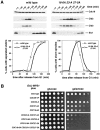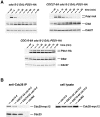Phosphorylation by Cdc28 activates the Cdc20-dependent activity of the anaphase-promoting complex
- PMID: 10871279
- PMCID: PMC2175139
- DOI: 10.1083/jcb.149.7.1377
Phosphorylation by Cdc28 activates the Cdc20-dependent activity of the anaphase-promoting complex
Abstract
Budding yeast initiates anaphase by activating the Cdc20-dependent anaphase-promoting complex (APC). The mitotic activity of Cdc28 (Cdk1) is required to activate this form of the APC, and mutants that are impaired in mitotic Cdc28 function have difficulty leaving mitosis. This defect can be explained by a defect in APC phosphorylation, which depends on mitotic Cdc28 activity in vivo and can be catalyzed by purified Cdc28 in vitro. Mutating putative Cdc28 phosphorylation sites in three components of the APC, Cdc16, Cdc23, and Cdc27, makes the APC resistant to phosphorylation both in vivo and in vitro. The nonphosphorylatable APC has normal activity in G1, but its mitotic, Cdc20-dependent activity is compromised. These results show that Cdc28 activates the APC in budding yeast to trigger anaphase. Previous reports have shown that the budding yeast Cdc5 homologue, Plk, can also phosphorylate and activate the APC in vitro. We show that, like cdc28 mutants, cdc5 mutants affect APC phosphorylation in vivo. However, although Cdc5 can phosphorylate Cdc16 and Cdc27 in vitro, this in vitro phosphorylation does not occur on in vivo sites of phosphorylation.
Figures








Similar articles
-
Cdc20 protein contains a destruction-box but, unlike Clb2, its proteolysisis not acutely dependent on the activity of anaphase-promoting complex.Eur J Biochem. 2000 Jan;267(2):434-49. doi: 10.1046/j.1432-1327.2000.01014.x. Eur J Biochem. 2000. PMID: 10632713
-
Cdc28 activates exit from mitosis in budding yeast.J Cell Biol. 2000 Jun 26;149(7):1361-76. doi: 10.1083/jcb.149.7.1361. J Cell Biol. 2000. PMID: 10871278 Free PMC article.
-
The regulation of Cdc20 proteolysis reveals a role for APC components Cdc23 and Cdc27 during S phase and early mitosis.Curr Biol. 1998 Jun 18;8(13):750-60. doi: 10.1016/s0960-9822(98)70298-2. Curr Biol. 1998. PMID: 9651679
-
Subunits and substrates of the anaphase-promoting complex.Exp Cell Res. 1999 May 1;248(2):339-49. doi: 10.1006/excr.1999.4443. Exp Cell Res. 1999. PMID: 10222126 Review.
-
Control of mitotic transitions by the anaphase-promoting complex.Philos Trans R Soc Lond B Biol Sci. 1999 Sep 29;354(1389):1583-90. doi: 10.1098/rstb.1999.0502. Philos Trans R Soc Lond B Biol Sci. 1999. PMID: 10582244 Free PMC article. Review.
Cited by
-
Dephosphorylation of Cdc20 is required for its C-box-dependent activation of the APC/C.EMBO J. 2012 Aug 1;31(15):3351-62. doi: 10.1038/emboj.2012.168. Epub 2012 Jun 19. EMBO J. 2012. PMID: 22713866 Free PMC article.
-
A Model of Yeast Cell-Cycle Regulation Based on a Standard Component Modeling Strategy for Protein Regulatory Networks.PLoS One. 2016 May 17;11(5):e0153738. doi: 10.1371/journal.pone.0153738. eCollection 2016. PLoS One. 2016. PMID: 27187804 Free PMC article.
-
Spatiotemporal regulation of the anaphase-promoting complex in mitosis.Nat Rev Mol Cell Biol. 2015 Feb;16(2):82-94. doi: 10.1038/nrm3934. Nat Rev Mol Cell Biol. 2015. PMID: 25604195 Free PMC article. Review.
-
An essential role for Cdk1 in S phase control is revealed via chemical genetics in vertebrate cells.J Cell Biol. 2007 Jul 16;178(2):257-68. doi: 10.1083/jcb.200702034. J Cell Biol. 2007. PMID: 17635936 Free PMC article.
-
Smad3 recruits the anaphase-promoting complex for ubiquitination and degradation of SnoN.Genes Dev. 2001 Nov 1;15(21):2822-36. doi: 10.1101/gad.912901. Genes Dev. 2001. PMID: 11691834 Free PMC article.
References
-
- Brown N.R., Noble M.E., Endicott J.A., Johnson L.N. The structural basis for specificity of substrate and recruitment peptides for cyclin-dependent kinases. Nat. Cell Biol. 1999;1:438–443. - PubMed
-
- Charles J., Jaspersen S.L., Tinker-Kulberg R.L., Hwang L., Szidon A., Morgan D.O. The Polo-related kinase Cdc5 activates and is destroyed by the mitotic cyclin destruction machinery in S. cerevisiae . Curr. Biol. 1998;9:497–507. - PubMed
Publication types
MeSH terms
Substances
LinkOut - more resources
Full Text Sources
Molecular Biology Databases
Miscellaneous

